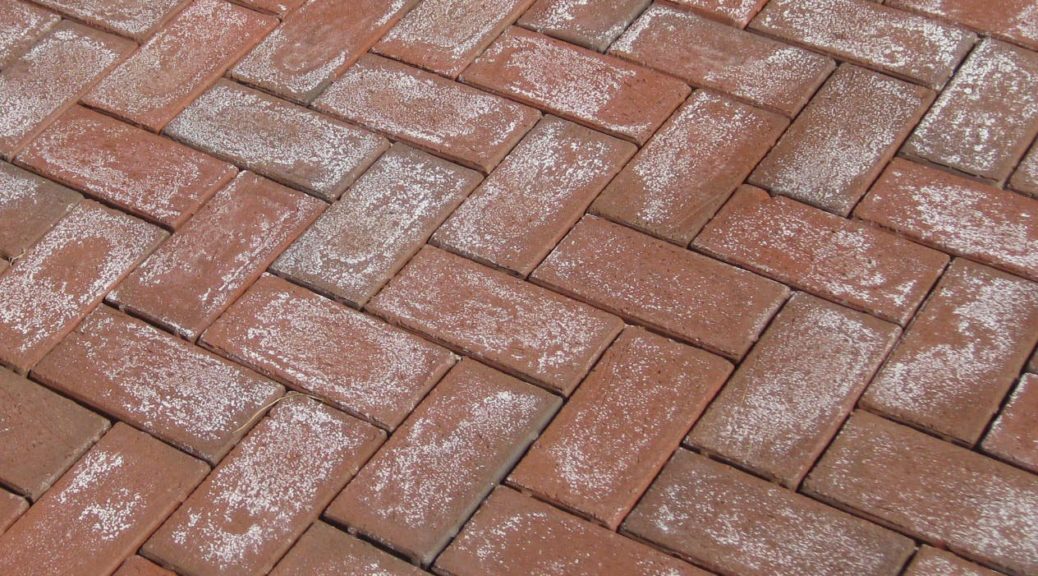
Cleaning Interlocking Pavers
When cleaning your pavers always use a broom to sweep off debris (a leaf blower also works but be careful not to blow out the joint sand) and a regular garden hose, with some dish soap. For more stubborn cleaning a pressure washer can be used but will result in some of the joint sand being washed away. If this is the case it may be easier and better to hire a professional to do the cleaning.
Professionals typically use a pressure washer and an applicator to apply efflorescence cleaner if needed (more on that later). The pressure loosens dirt and pushes water from the surface without the need for scrub brushes. The nozzle type and its distance from the paver surface influences the effectiveness of the cleaning as well. A nozzle that creates a wide spray enables a large area to be covered efficiently and reduces the chance of sand being washed from the joints. Using a low angle with a wide nozzle will further lower the amount of sand washer out of the joints. Cleaners to remove efflorescence are applied with a low pressure pump sprayer. Allow the cleaner to sit an appropriate time, then rinsed away with a high pressure sprayer. The final rinse should be water only. A large amount of water is more important to rinsing than high pressure.
For small areas, an adequate cleaning job can be achieved without this equipment. Such areas include residential patios, walks, or small driveways. Cleaners can be applied by hand, the pavers scrubbed to remove dirt and efflorescence, then thoroughly rinsed with water from a garden hose. Do not use scrub brushes with steel bristles, they will mark the pavers and if they loosen from the brush they will possibly leave rust stain, a stiff bristle broom is more than adequate. If a broom doesn't provide enough scrubbing power a brass or plastic bristle scrub brush is acceptable.
Efflorescence and Its Removal
Efflorescence is a whitish powder-like deposit which can appear on concrete products. When cement cures, a significant amount of calcium hydroxide is formed. The calcium hydroxide is soluble in water and migrates by capillary action to the surface of the concrete. A reaction occurs between the calcium hydroxide and carbon dioxide from air to form calcium carbonate, this is what we call efflorescence.
Efflorescence does not affect the quality performance or durability of concrete pavers.
The reaction that takes place is the formation of water soluble calcium bicarbonate from calcium carbonate, carbon dioxide and water. It may appear immediately or within months following installation, or may not appear ever depending on where you live. Efflorescence may reach its peak in as short as 60 days after installation. It may remain for months and some of it may wear away. If installation takes place during dry period of the year, the next cycle of wet weather may sometimes be necessary for efflorescence to materialize. If there is a need to remove deposits before they wear away, best results can be obtained by using an efflorescence remover.
The acid in efflorescence cleaning chemicals is buffered and blended with other chemicals to provide effective cleaning without damage to the paver surface. Always refer to the paver supplier or chemical company supplying the chemicals for recommendations on proper dilution and application of chemicals for removal of efflorescence.
As always read the directions, most cleaners should not be allowed to dry on the surface of the pavers.
Efflorescence cleaners are generally applied in small sections beginning at the top of slope of the pavement. If the area is large, a sprayer is an efficient means to apply the cleaner. The chemicals are scrubbed on the surface, then rinsed away. Results can be verified after letting the area dry for at least 24 hours. In most instances one application is sufficient. However, in severe instances of efflorescence, a second application may be necessary. Read the directions or contact the manufacturer of the cleaning product to determine if a second application will not discolour the pavers or expose some aggregates.
Note: Protective clothing, chemical resistant rubber boots and gloves, and eye goggles should be worn when applying acid or alkalies.